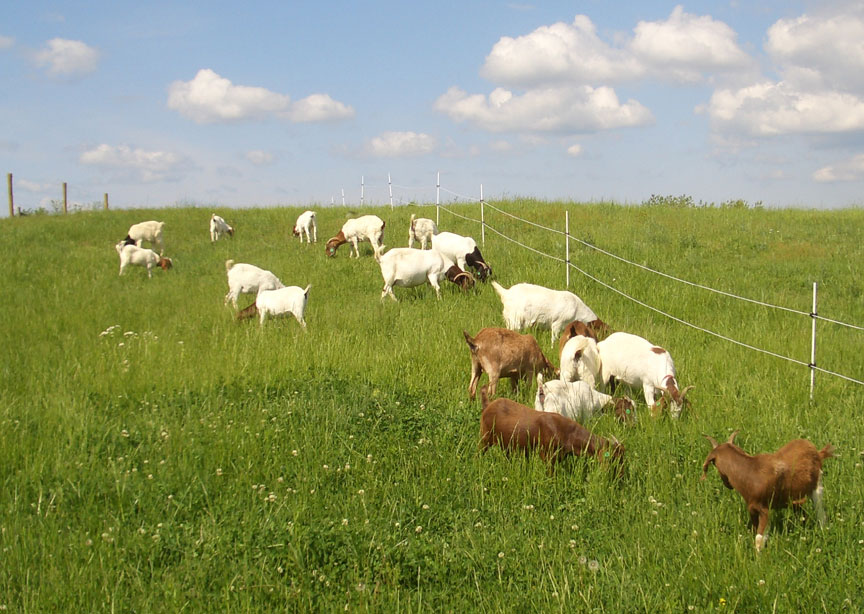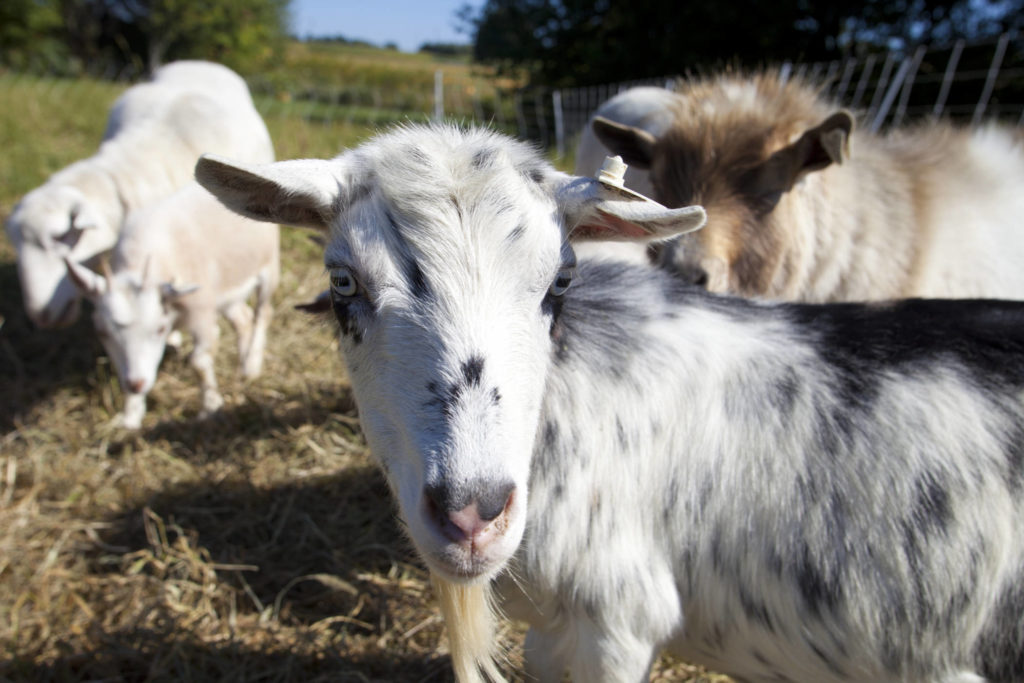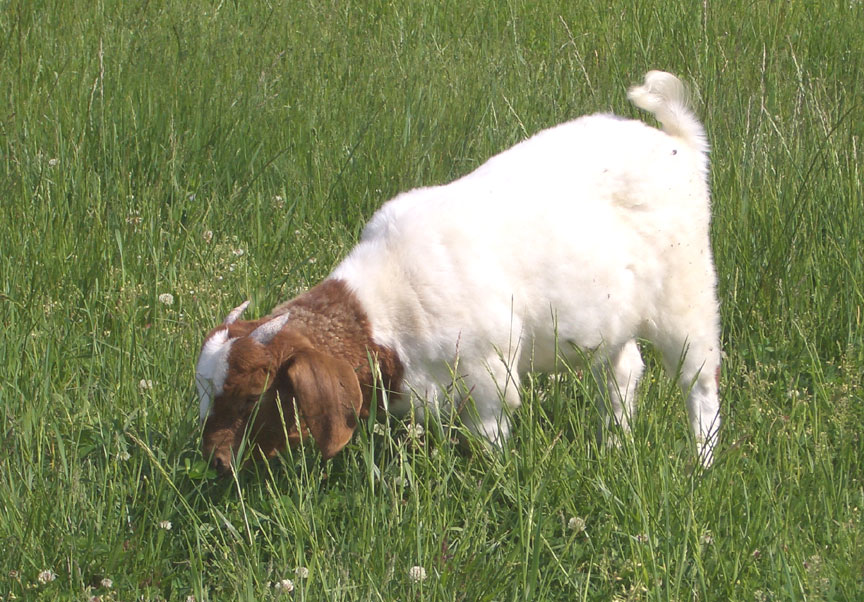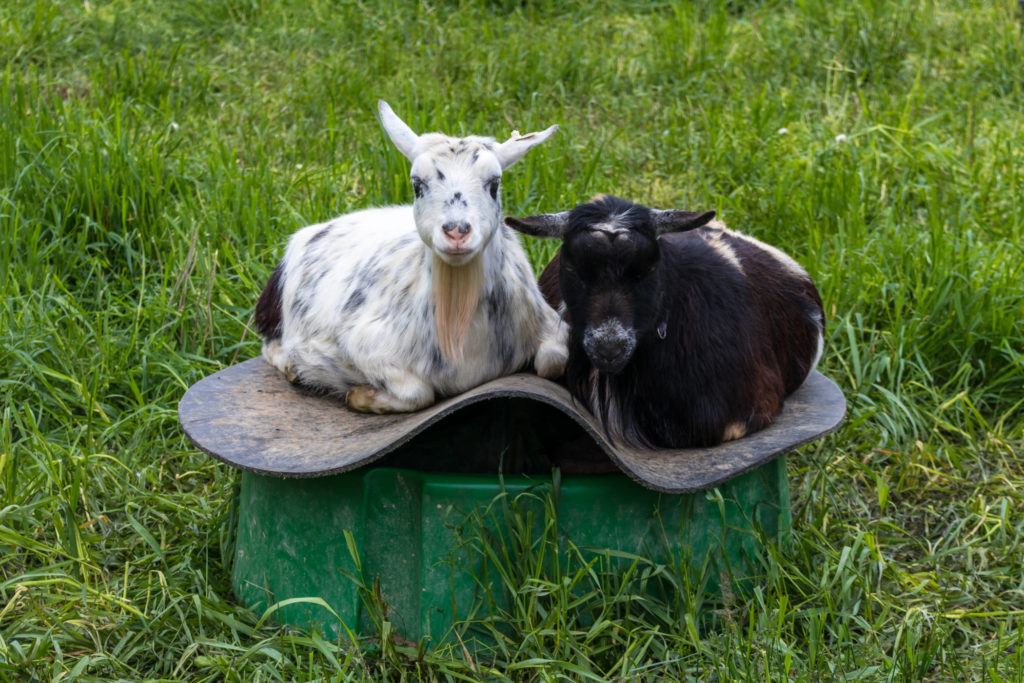Originally published in New Farm on July 20, 2004
When Eric Finch’s wife, Deb, brought home a nanny goat in January 2002 from the vet clinic where she works, this Iowa farm couple never suspected it would help them launch a profitable niche business.
Three years of goat production later, the Finches have tapped into a booming market among the local Hispanic population in nearby Marshalltown. They have expanded production several times, but can’t keep up with demand – even without advertising.
With his wife’s father and brothers, the family raises 800 acres of corn and runs a 1,000-sow farrow-to-finish operation. Eric and Deb expanded their goat breeding herd to 150 head and are raising about 175 kids this year. The couple would like to expand the herd to 200 or 250 head next year.
Their situation isn’t unique. According to the American Meat Goat Association, the U.S. meat goat industry is experiencing an average growth rate of 12 percent each year in production and still can’t produce as much as consumers want. “There’s a huge demand for goat meat,” said Eric, 27. “It’s consumed by 70 percent of the world’s population and is very popular among many ethnic groups here in the United States.”
That’s just one of the many good reasons to raise meat goats, added Finch, who serves as secretary for the new Iowa Meat Goat Association. Finch said meat goats also:
Grow quickly and are easier to raise than other livestock. “You don’t need a lot of land like you do with cattle, and you don’t need a lot of buildings like you do with hogs,” said Finch.
Offer income potential within seven to eight months of breeding. Goats have a five-month gestation. The kids can be weaned at three months at 45 to 55 pounds and can go directly to market.
Provide a tax benefit in some states. “Most people who have an acreage want horses, but in Iowa they aren’t considered livestock for tax purposes,” Finch said. “Goats can classify you a farm business and offer some tax benefits.” Consult your tax adviser for more information.

Which breed is best?
If you want to get started with meat goats, you can’t beat the Boer breed, which is known for its tremendous growth rate. “This is the best meat goat you’re going to find,” said Finch, who recently taught a community-college class in meat goat production and marketing.
Finch has a closed herd with a full-blooded Boer buck and crossbred females ranging from one half to three-quarter Boer blood. The adult does range from 150 to 200 pounds, while the buck weighs in at 300 pounds. Finch’s goat crops have ranged from 160 to 180 percent, with twins, triplets and a few quadruplets.
The Finches also have some Spanish meat goats but say this breed tends to be more flighty. Other meat goat breeds include Kiko (which offer a good growth rate and have been selected for twinning) and Myotonic (easy keepers that are capable of two kiddings per year and are known for a heavy rump and deep chest).
“You don’t have to start with purebreds,” Finch said. “You can get good crossbreeds to get started. Check with your state goat association to find reputable sellers.”
In central Iowa, purebred bucks and does cost $500 or more per animal. Commercial does that are three months of age to one year range from $125 to $250 a piece, depending on how much Boer blood they have. Finch sells his for $150. Commercial bucks can be found for $200 a piece.
Kidding areas with pens should measure 5 feet by 6 feet. Depending on the climate in your region, you may not need kidding pens if the babies are born in April or May.
Match facilities and fencing to goats’ needs
Once you decide which breed you’d like to raise, what kind of facilities will you need? You can keep eight to 10 goats per acre of pasture with rotational grazing, Finch said. If you have more goats than pasture as Finch does, plan on 20 square feet of dry lot per head. Since goats don’t like rain, you’ll need to provide shelter. Plan on 10 square feet per doe, Finch advised. “We use an old cattle loafing shed with three sides, and we curtain the fourth side in the winter,” Finch said.
Kidding areas with pens should measure 5 feet by 6 feet. Depending on the climate in your region, you may not need kidding pens if the babies are born in April or May, said Finch, whose kidding season runs from late December through May.
Don’t forget fencing, which can be one of your most important investments. You can use woven wire, high-tension electrified wire or a combination of both. Some companies, like Keystone Steel and Wire Co. (www.redbrand.com) make fence designed especially for goats. “We had trouble with goats getting their horns caught in the woven wire, so we added a strand of hot wire about 16 to 18 inches off the ground,” Finch said. “We also took Roundup® and sprayed the fence area so the goats didn’t have any reason to stick their heads through.”

What do I feed?
What you feed your meat goats and how you feed them will play a major role in your profitability. Goats are natural browsers, but in Iowa they can’t be raised on pasture exclusively and will need feed supplements, including high-selenium trace mineral salt.
Here’s Finch’s feeding program, by phase:
• Maintenance = pasture and free choice mineral/salt
• Late gestation (last six weeks) = free-choice hay, three-fourths of a pound of grain per doe, and mineral/salt
• Lactation (with a single kid) = free choice hay (Finch uses his best alfalfa), 1.25 pounds of grain per doe, and mineral/salt
• Lactation (with twins) = free-choice hay (Finch uses his best alfalfa), 2 pounds of grain per doe, and mineral/salt
Finch feeds his goat kids a complete mini-pellet with 18 percent protein. He uses stainless steel nursery pig feeders to deliver the self-fed creep feed. “Once the kids get started on creep feed, they eat it like crazy,” Finch said. To keep does out of the creep feed, Finch cut holes in a cattle panel that would accommodate only goats weighing up to 30 pounds.
Weanlings and replacement goats receive a self-fed, 16-percent protein pellet and roughage comprised of the brome and orchard grass Finch bales from his fields’ waterways. “Many companies supply goat rations,” added Finch, who buys most of his feed and supplements in bulk to save money. “We have a local feed mill make the formula we want.”
Adult goats receive a mixed ration comprised of six parts shelled corn and one part pellet with 14 percent protein. Old turkey feeders and livestock troughs work well for feeding the older animals. Don’t feed straight corn, because goats will founder and have hoof problems, Finch advised. “We don’t crack or grind the shelled corn we feed to the goats, because this can cause acidosis.”

Keeping goats healthy
Controlling worms, trimming hooves, and vaccinating on time are the keys to keeping goats healthy. Finch vaccinates for clostridium perfringens C & D and tetanus. “You can vaccinate for other conditions, but we’ve found we’ve been covered with these two shots,” Finch said. Kids receive the first shot within a week of their birth, the second one 21 days later. Does and bucks receive an annual booster shot in the fall when they come off pasture.
Parasite control is a big issue in a goat herd, since goats have little natural resistance to worms. Use fecal samples to determine your herd’s worm load. “We treat for worms in the spring and the fall,” Finch said. “We also treat individual goats, as needed, during the summer.” Finch also rotates his wormers including Ivomec®, Safeguard® and Valbazen® annually so resistance doesn’t build up in the herd.
Since Finch puts his goats on a regular de-worming schedule, he doesn’t run many fecal samples. But if he suspects a problem, he’ll collect a fresh fecal sample in a plastic bag and send it to the local vet clinic for testing. Tests usually range from $5 to $10 each.
Basic herd health maintenance must include hoof trimming. “There’s no way around it,” Finch said. “Get a good pair of trimmers, because goat hooves are really tough. One tip is to trim them after a rain has softened them up.” Finch advises cleaning the mud out of the hooves, trimming the hooves and treating the hoof area with Coppertox® right away if there’s any bleeding to control the risk of bacterial infection.
What about castration? “I band most of my males,” Finch said. “They’ll go off feed and lose weight, but they’ll come back.”
Comparing options for marketing
Once your goats reach market weight, you have several marketing options. They can go directly to consumers, directly to slaughter, or they can be sold at a sale barn, depending on options available in your location and your personal preferences.
Before you do anything, run the numbers to determine your cost of production, Finch advised. “I’ve used the Minnesota Meat Goat Enterprise Budget to enter everything from my feed and mineral costs to my kidding rate. It shows my actual cost of production is $50 to $55 per year per doe” (www.auri.org/research/goatmeat/budget.htm).
Once you calculate your cost of production (or at least estimate it if you’re new to the business), you’ll know how much you need to receive to break even and make a profit. This is especially important if you sell directly to consumers.
Finch markets nearly all his goats directly to Hispanic consumers who live in and around Marshalltown, the county seat town 20 miles from the Finch farm. Hispanics make up more than 20 percent of the Marshalltown’s population, according to figures from the Marshalltown Chamber of Commerce.
“Our goat business got started because a couple of the Hispanics who work for us on the swine farm told their friends we had goats for sale,” said Finch, who marketed more than 300 goats in 2003, up from 130 in 2002. “We don’t do any advertising—it’s all word of mouth.”
Finch’s goats are sold by the head and are sold live. Most customers buy one to three goats at a time. For special occasions like a wedding party, buyers might take as many as 12 goats. There are benefits and drawbacks to marketing direct to consumers, Finch noted.
“On the plus side, you get to the set the price, you get cash in hand immediately, the buyers come to you, and there are no trucking and/or commission charges. But there can be biosecurity issues and inconvenient, unexpected visits from customers.”
When buyers come to the farm, they are not allowed to go near the kidding barn for biosecurity reasons. Finch has also established marketing days of Friday nights and Saturday mornings to make the process easier. But some customers drop in whenever they want. “Then they get upset if I’m not at the farm, so I encourage them to call ahead so I can be there,” Finch said.
Pricing creates another challenge. “In Mexico it’s common to haggle over prices,” Finch explained. “So I’ll have customers who try to get a $75 goat for $50. I don’t haggle over price. It’s not worth it, and most buyers will pay your price. Plus, you don’t want word to get around that you’re willing to lower your price.”
Finch sets his prices by determining his cost of production per animal sold, knowing what the local market will bear, and charging enough to earn a reasonable profit.
If you sell to the ethnic market, also learn each group’s specific needs. “Each ethnic group wants something different,” Finch said. “Hispanics don’t want bucks, but Africans and Sudanese prefer bucks, because they say the meat has more flavor. For certain holidays, Muslim customers want only a perfect, unblemished, full-grown animal over a year old.”

Other marketing options
If direct marketing isn’t your style, you can sell to a local sale barn or slaughter facility. While sale barns are often closer to home, realize that you’re not guaranteed a price. You can also lose income with commissions, yardage, inspection fees, and other costs.
If you’d like to alleviate some of this price fluctuation — but don’t want to direct market — you can deliver your goats directly to a slaughter facility. The price is set prior to arrival and there are no commission fees, but you will have to pay for trucking.
Finch’s nearest slaughter facility is located in Shannon, Ill., 200 miles one way from his farm. Recently this buyer was bidding $1.30 per pound live weight on 30- to 50-pound goats. The buyer will take heavier goats, but the seller will be docked.
Finch’s most profitable market weight for goats ranges from 40 to 60 pounds, and he sells 90 percent of his goats in this range. A 40-pound goat will bring about $60, while a 60-pound goat will bring about $80. That’s worth noting, because local Hispanic buyers usually aren’t willing to pay more than $80 for a goat.
“It’s not what you get per pound that’s important—it’s what you need per head to make a profit,” Finch noted. That’s why you need to use some type of enterprise budget to determine your actual cost of production and develop a profitable marketing plan.”
Keep learning
As the demand for meat goats continues to grow, the Finches say they enjoy sharing their knowledge of the business. “When we started out, we didn’t have anyone to turn to for answers,” Deb Finch said. “Everyone told us raising goats is like raising sheep, but there are some big differences. We’ve learned from experience, and we’re happy to help others.”
For more updates on Rodale Institute’s research and programming, follow us on Facebook, Instagram, and Twitter.
